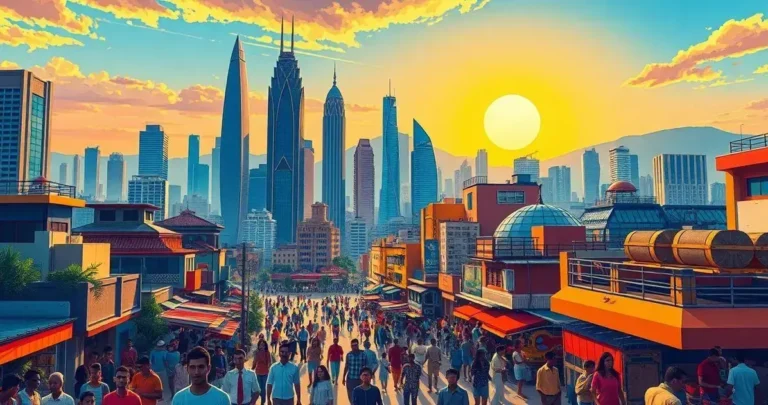Announcements
Emerging economies are nations undergoing rapid industrialization and growth, characterized by a rising middle class and significant investment opportunities.
Despite facing challenges like political instability and infrastructure deficits, they present vast potential for investors looking to diversify and capitalize on future trends.
Emerging economies are reshaping the landscape of global finance and commerce.
Announcements
As nations undergo rapid industrialization and urbanization, they present unique opportunities and challenges.
Definition of Emerging Economies
An emerging economy refers to a nation that is transitioning from a developing status to a more industrialized and developed economy.
Announcements
These countries often experience rapid growth, increased foreign investment, and evolving markets.
Emerging economies are characterized by improvements in infrastructure, manufacturing, and services.
Key Features of Emerging Economies
Typically, these economies list factors such as rising gross domestic product (GDP), a growing middle class, and an increase in foreign direct investment (FDI).
Due to these factors, emerging economies attract global attention and investment, which can further accelerate their development.
Examples of Emerging Economies
Countries like Brazil, India, China, and South Africa are frequently cited as examples of emerging economies.
They showcase significant economic growth, expanding markets, and potential for investors to tap into diverse sectors like technology and consumer goods.
Comparison with Developed Economies
Unlike developed economies, emerging economies often face unique challenges.
These include lesser stability in political systems, fluctuating currencies, and reliance on specific sectors such as agriculture or raw materials.
However, their dynamism offers numerous opportunities for growth and innovation.
As they evolve, the global economic landscape shifts, posing both risks and benefits for businesses and investors worldwide.
Understanding the definition of emerging economies is crucial for navigating these unique economic landscapes.
Key Characteristics of Emerging Economies
Emerging economies possess several unique characteristics that set them apart from developed nations.
These features are essential for understanding their rapid growth and the opportunities they present.
1. Rapid Economic Growth
One of the most significant characteristics of emerging economies is their rapid economic growth.
These nations often experience a faster rate of growth in GDP compared to developed countries, driven by industrialization and technological advancements.
2. Growing Middle Class
Emerging economies usually have a burgeoning middle class.
This group is significant as it increases consumer spending, transforms lifestyles, and drives demand for various products and services.
3. Infrastructure Development
A key factor in the progress of emerging economies is their emphasis on infrastructure development.
Investments in transportation, communication, and energy sectors are essential to support economic activities and enhance quality of life.
4. Foreign Direct Investment (FDI)
Emerging economies attract substantial foreign direct investment due to their developing markets and growth potential.
International investors look for opportunities in sectors like technology, manufacturing, and natural resources.
5. Volatility and Risks
While there are numerous advantages, emerging economies also face challenges such as economic volatility and political instability.
This can create risks for investors but also opportunities for those who can navigate these complexities.
By understanding these key characteristics, investors and businesses can better assess the potential within emerging economies and make informed decisions regarding their engagement with these dynamic markets.
Challenges Faced by Emerging Economies

Emerging economies, while full of potential, face numerous challenges that can hinder their growth and development.
Understanding these issues is vital for investors and stakeholders.
1. Political Instability
Political instability is a significant concern in many emerging economies.
Frequent changes in government, civil unrest, or lack of strong governance can lead to uncertainty, making it difficult for businesses to operate effectively.
2. Economic Volatility
Emerging economies can experience rapid fluctuations in their economic performance.
This volatility can arise from factors like changes in commodity prices, global market shifts, or economic policies that may not be well-defined.
Investors must be cautious when entering these markets.
3. Infrastructure Deficiencies
Many emerging economies struggle with insufficient infrastructure.
Problems may include inadequate transportation systems, unreliable energy supply, and limited access to modern technology.
These deficiencies can slow economic growth and deter foreign investment.
4. Limited Access to Capital
Accessing capital is often challenging for businesses in emerging economies.
Financial institutions may be underdeveloped, leading to higher costs for loans and reduced funding options for startups and small businesses.
5. Social Inequality
Social inequality is a pressing issue in many emerging economies. Disparities in wealth, education, and healthcare can limit the overall potential of the workforce.
This inequality may also create social tensions that can further impact economic stability.
Addressing these challenges is crucial for the sustainable growth of emerging economies.
By understanding their struggles, stakeholders can better navigate the opportunities for investment and collaboration.
Opportunities for Investors in Emerging Economies
Investing in emerging economies offers a range of exciting opportunities for investors seeking growth and diversification.
These unique markets often present prospects that are unmatched in more developed nations.
1. High Growth Potential
Emerging economies frequently experience rapid economic growth.
Investors can capitalize on this by entering markets early, benefiting from the high growth potential of various industries such as technology, energy, and consumer goods.
2. Diversification of Investment Portfolio
Diversifying investment portfolios with assets from emerging economies can reduce risk.
By including various markets, investors can spread their exposure and balance potential volatility in developed markets.
3. Expanding Consumer Base
As middle classes grow in emerging economies, so does consumer demand.
Investors can tap into a larger consumer base that seeks diverse products and services, providing opportunities for businesses and start-ups to flourish.
4. Access to Untapped Resources
Emerging economies often hold vast natural resources that remain largely untapped.
This offers investors opportunities to explore sectors like mining, agriculture, and renewable energy, which can yield substantial returns.
5. Government Incentives
Many countries in this category implement policies to attract foreign investment.
Tax incentives, grants, and reduced regulations can make investing in emerging economies more appealing for foreign investors.
Understanding these opportunities can help investors make informed decisions and strategically engage with the dynamic growth prospects of emerging economies.
Investing now can pave the way for significant returns in the future.
Future Trends in Emerging Economies
Future trends in emerging economies are set to shape the global economic landscape dramatically.
Observing these trends can help investors and businesses prepare for the changes ahead.
1. Digital Transformation
Emerging economies are rapidly adopting technology. This digital transformation enhances business operations and opens new markets.
E-commerce, mobile banking, and online services are becoming more prevalent, changing how consumers engage with products and services.
2. Sustainable Development
As global awareness of climate change increases, emerging economies are increasingly focusing on sustainable development.
Investments in green energy and sustainable agriculture are on the rise, leading to new business opportunities and advancements in infrastructure.
3. Urbanization and Infrastructure Growth
With urban populations growing, there is a demand for improved infrastructure.
Cities in emerging economies will need better transportation, housing, and public services, sparking investment and development projects.
4. Shifts in Global Trade
Emerging economies are becoming significant players in global trade.
Countries like India and Brazil are expanding their markets, which will reduce dependency on traditional trading partners and diversify global supply chains.
5. Increased Investment in Technology
With a young and tech-savvy population, emerging economies are attracting investment in technology sectors, including artificial intelligence, fintech, and biotechnology.
This growth can lead to innovations that support economic development and improve quality of life.
By staying informed about these trends, businesses and investors can position themselves to take advantage of the opportunities arising in emerging economies in the coming years.
FAQ – Frequently Asked Questions about Emerging Economies
What are emerging economies?
Emerging economies are nations transitioning from a developing status to a more industrialized economy, often experiencing rapid growth and increased foreign investment.
What are the key characteristics of emerging economies?
Key characteristics include rapid economic growth, a growing middle class, infrastructure development, foreign direct investment, and certain degrees of volatility and risks.
What challenges do emerging economies face?
Challenges include political instability, economic volatility, infrastructure deficiencies, limited access to capital, and social inequality.
What opportunities exist for investors in emerging economies?
Opportunities include high growth potential, portfolio diversification, an expanding consumer base, access to untapped resources, and government incentives.
What are the future trends in emerging economies?
Future trends include digital transformation, sustainable development, significant urbanization and infrastructure growth, shifts in global trade, and increased investment in technology.
How can investors prepare for changes in emerging economies?
Investors can stay informed about market trends, understand the political and economic environment, and seek opportunities in sectors aligned with future growth.







